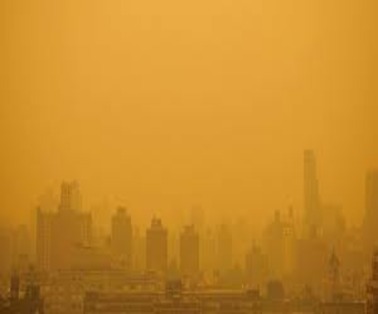India was the world’s eighth most polluted country in 2022. The ranking was decided by Swiss firm IQAir in its ‘World Air Quality Report’
Key Points On World Air Quality Report
- The World Air Quality report is based on the level of PM 2.5, a pollutant closely tracked by scientists and health experts.
- While the PM 2.5 level has dipped to 53.3 micrograms/cubic metre, that is still over 10 times the World Health Organisation’s safe limit for India
- The data from 131 countries is taken from over 30,000 ground-based monitors, either government or non-government operated for the World Air Quality report
- IQAir is a Swiss air quality technology company that prepares annual world air quality reports based on data from monitoring stations operated by governments and other institutions and organisations across the world.
World Air Quality Report Ranking
|
Rank |
10 most polluted countries in the world |
|
1 |
Chad |
|
2 |
Iraq |
|
3 |
Pakistan |
|
4 |
Bahrain |
|
5 |
Bangladesh |
|
6 |
Burkina Faso |
|
7 |
Kuwait |
|
8 |
India |
|
9 |
Egypt |
|
10 |
Tajikistan |
Indian Cities In World Air Quality Report

Status
- In India, the transport industry is responsible for 20–35% of the country’s PM2.5 pollution. The use of biomass fuels, industrial facilities, and coal-fired power plants are other contributors of air quality degradation.
- Pollution levels have decreased in NCR areas including Noida, Ghaziabad, Gurugram, and Faridabad.
- The research claims that pollution levels have significantly decreased in 31 cities, including 10 cities in Uttar Pradesh and 7 cities in Haryana.
- According to the survey, there has been an increase in pollution in 38 cities and towns overall compared to the national average over the previous years
PM 2.5
- Particulate matter (PM) consists of a mixture of solid particles and liquid droplets suspended in the air.
- These particles come from various sources, including vehicle emissions, industrial processes, construction activities, agricultural activities, wildfires, and natural dust.
- PM can be classified into different size categories based on its aerodynamic diameter.
- Common size fractions include PM10 (particles with a diameter of 10 micrometres or smaller) and PM2.5 (particles with a diameter of 2.5 micrometers or smaller).
- PM 2.5 is an atmospheric particulate matter of diameter of fewer than 2.5 micrometres, which is around 3% the diameter of a human hair.
- PM 2.5 particles are small enough to penetrate deep into the lungs and even enter the bloodstream, and long-term exposure to PM 2.5 can lead to lung cancer, heart disease, stroke, and other chronic health conditions.
Significance
- Air pollution is now considered to be the world’s largest environmental health threat, accounting for seven million deaths around the world every year.
- Air pollution causes and aggravates many diseases, ranging from asthma to cancer, lung illnesses and heart disease.
- Air pollution affects those that are most vulnerable the most.
- Further, in this age of Covid-19, researchers have found that exposure to PM2.5 increases both the risk of contracting the virus and of suffering more severe symptoms when infected, including death
How Air Quality Can be Enhanced in India?
- Link Zero Emissions with Human Rights: Air pollution needs to be recognized more as a human right issue rather than merely as an environmental challenge, and should be linked with the mission of net zero emission (by 2070).
- The UN General Assembly (UNGA) has also passed a resolution recognizing the right to a clean, healthy, and sustainable environment as a human right.
- Green-Transition Finance: There is a need to create a financial architecture that can mobilise private finance for clean-air solutions in India. Green sectors such as clean energy and e-mobility offer tangible solutions to improve air quality.
- Bio Enzyme-PUSA: A bio-enzyme called PUSA has been developed by the Indian Agriculture Research Institute as a solution to stubble burning.
- As soon as it is sprayed, this enzyme starts decomposing the stubble in 20-25 days, turning it into manure, which further improves the soil.
- Ready-Made Concrete for Construction: Construction dust is a major contributor to pollutants in air in expanding cities.
- To deal with this situation, Niti Aayog has suggested the use of ready-made concrete that can minimise environmental impacts of building activities.
To Download Monthly Current Affairs PDF Click here
Click here to get a free demo
Everything About CLAT 2025
Frequently Asked Questions
‘World Air Quality Report’ is based on the level of?
‘World Air Quality Report’ is based on the level of PM 2.5
Long-term exposure to PM 2.5 can lead to?
Long-term exposure to PM 2.5 can lead to Lung cancer, Heart disease and Stroke
PM 2.5 is an atmospheric particulate matter of which diameter?
PM 2.5 is an atmospheric particulate matter of diameter of fewer than 2.5 micrometres



